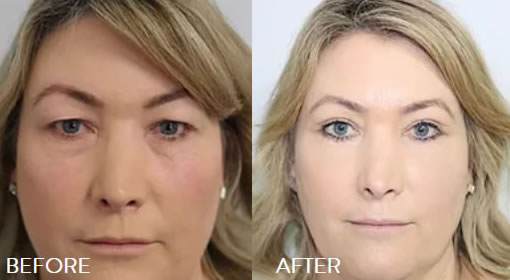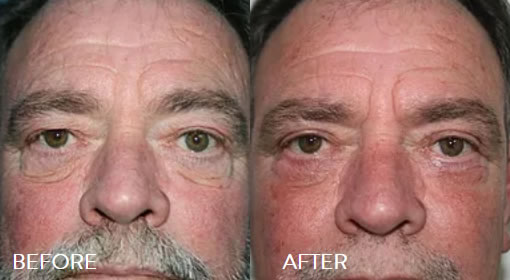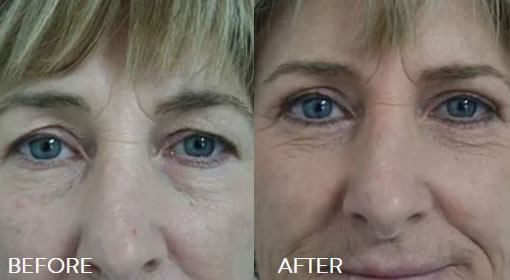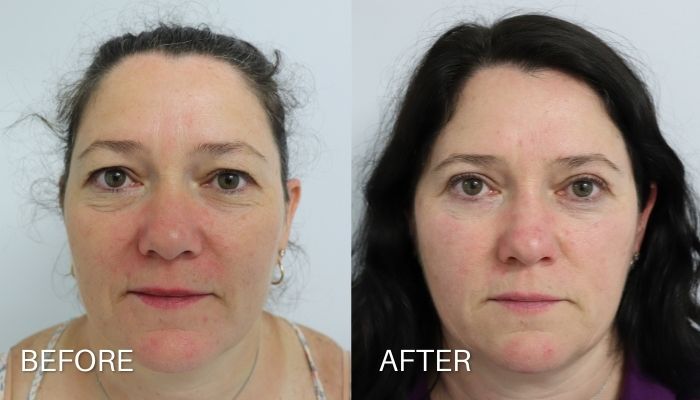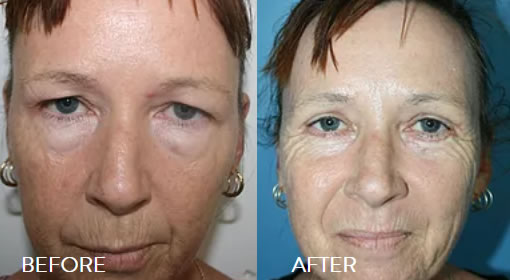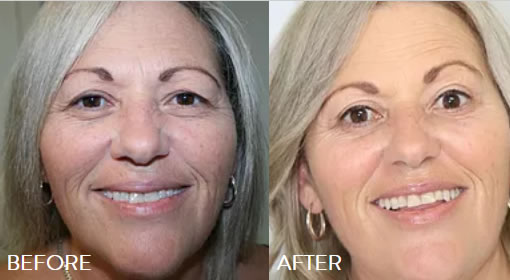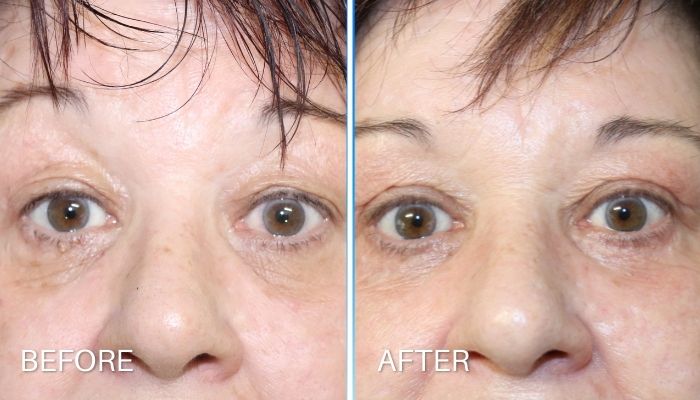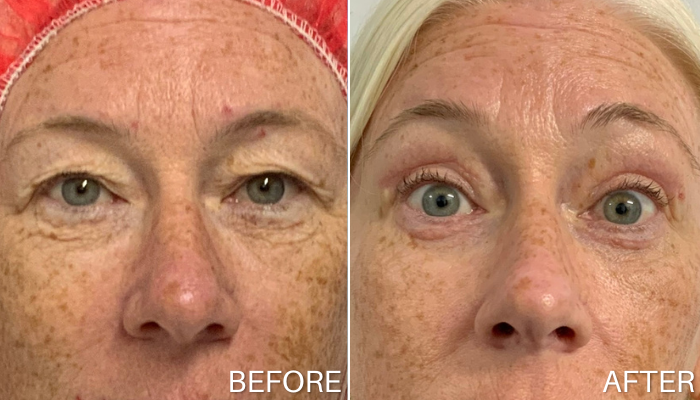If you are unhappy with the appearance of your eyelids, cosmetic eyelid surgery (blepharoplasty), also called an Eye Lift, may offer the improvement you seek.
Eyelid surgery can remove drooping skin and excess fat of the upper eyelids, reduce under-eye bags and tighten the lower eyelid skin.
View our Frequently Asked Questions below to find out more about blepharoplasties.
Frequently Asked Questions
Blepharoplasty (eyelid surgery or ‘eye lifts’) is most often performed to correct the effects of ageing in the upper and lower eyelids. However, it can also offer benefits to younger men and women as well. Many individuals begin to see changes in their eyelids as early as their mid-30s, and even patients in their 20s have undergone eyelid surgery to enhance their appearance.
Good candidates for eyelid surgery include healthy men and women with any of the following conditions:
Upper eyelids
– Puffiness
– Excess skin hiding the natural eyelid fold
– Loose eyelid skin, sometimes obstructing vision
– Hooded eyes
Lower eyelids
– Excess skin
– Fine wrinkles in the lower eyelid area
– Bags, puffiness and dark circles
Though eyelid surgery offers great benefits, the procedure should to be approached with extra caution for those with any of the following medical conditions:
– Circulatory disorders, including high blood pressure
– Thyroid problems
– Lower eyelids with excessively significant droop
– Dry eye, glaucoma, a detached retina or other eye problems
– Cardiovascular disease
– Diabetes
If you have any of these medical conditions, it is important to advise Dr McHugh during consultation.
A personal consultation with your surgeon is the first step for any patient considering blepharoplasty. Dr McHugh will assess your physical and emotional health, discuss your aesthetic goals, and address any questions or concerns you may have.
Issues you should be prepared to discuss during consultation with Dr McHugh include:
– All medical conditions, both past and present
– Any allergies, especially those affecting the eyes
– Current medications, including nutritional supplements and herbal remedies
– Past surgeries
– Other treatments you’ve undergone or are considering
During your consultation, Dr McHugh will assess your overall eyelid contour, the amount of excess eyelid fat and skin you possess, your eyebrow position, and the condition of the muscles in the area.
For a more complete rejuvenation, Dr McHugh may discuss additional procedures that can be performed along with eyelid surgery. Patients frequently combine eyelid surgery with:
– Forehead lift: to diminish horizontal forehead wrinkles and lift sagging brows
– Laser resurfacing: to reduce the appearance of fine lines and crows feet
– Additional eyelid surgery: to improve lower-eyelid muscle tone
The blepharoplasty technique Dr McHugh uses for you depends upon your individual features and aesthetic goals. Dr McHugh will discuss your options with you during your consultation.
Upper eyelid surgery
This procedure removes excess skin and fatty tissue from the upper eyelid. It is performed using incisions hidden in the natural contour of the eyelid. Each incision typically begins within the inside corner of the eye and runs just beyond the outside corner. It is through these incisions that dissection and fat removal are performed.
Lower eyelid surgery
This procedure is typically performed using incisions concealed just below the lower lash-line. Excess skin, fat and muscle are removed to improve the eye’s appearance. Dr McHugh may also choose to tighten underlying muscle and redistribute fat beneath the eye to reduce the look of puffiness.
Transconjunctival blepharoplasty
This lower eyelid procedure removes unwanted fat from the area. Using an internal incision, placed inside the lower eyelid, this option offers the advantage of no external incisions although it is seldom advised since most patients require some skin excision as well which obviously requires an external incision.
Because cosmetic eyelid surgery cannot address wrinkles and crows feet, it is often combined with treatments such as laser resurfacing for a complete rejuvenation.
Though thousands of people undergo blepharoplasty each year and experience no major complications, the procedure does carry some degree of risk. It is important you be well informed of these risks when considering blepharoplasty.
The discussion of potential risks and complications is one of the most important aspects of patient consultation. During your consultation, Dr McHugh will discuss these potential complications with you, listen to your safety questions, and offer recommendations on how to minimise your risk.
It is important to follow Dr McHugh’s instructions when preparing for surgery to ensure the best possible results. Those instructions may include:
– Refraining from smoking for several weeks before and after surgery
– Avoiding certain medications
– Arranging for help following surgery, such as a ride home and in-home care for the first 24 hours
– Growing your hair to cover your incisions as they heal
For your comfort and convenience, Dr McHugh operates either in his clinic under local anaesthetic with intravenous sedation or under general anaesthetic at various private hospitals.
He will carefully monitor your physical status throughout the operation and during your recovery.
Directly after surgery, you’ll be taken to a recovery area and carefully monitored.
Temporary blurring of vision is common during this time due to ointment used to protect and lubricate the eyes. Tightness around the eyes should also be expected, but should diminish when the swelling subsides. Though pain after surgery is generally minimal, it can be controlled with pain medication. Bruising and swelling should also be expected and may be minimised using cold compresses. The amount of swelling and bruising and the length of time it will last will vary from patient to patient.
Though everyone heals at a different pace, the following is typical of recovery from blepharoplasty:
The day of surgery
– Resting with your head elevated is essential during this time
– Swelling should be expected, reduced with cold compresses
The first week
– Bruising will reach its peak, then begin to subside
– Blurred vision, excess dryness or tearing, sensitivity to light and itching may occur
– Makeup may be applied to conceal discoloration
– Stitches will dissolve or be removed
– Normal, non-strenuous activities will be permitted
After several weeks
– Your final result will begin to emerge
– Most swelling will disappear
– Blurring will subside
– Bending, lifting and exercise will be permitted
– Contact lenses can be worn
Most people who undergo blepharoplasty are very pleased with their results fairly soon after their procedure. Many report looking refreshed and more alert after their eyes have had a chance to heal. Most traces of surgery will subside after several weeks.
After surgery, the skin around your eyes must be carefully protected from the sun and wind. Sunblock and darkly tinted sunglasses will be needed.
Though the results of blepharoplasty are long lasting, no surgical procedure will stop the ageing process. Dr McHugh can advise you on how best to maintain your refreshed look.
Follow-up visits are important to answer any questions you may have and monitor your healing process. Your first post-operative visit will be scheduled after the initial healing period, during the first few days after surgery.
In the following months, Dr McHugh may ask you to return for periodic checkups. Keeping these appointments is important to assess your long-term results and address any questions or concerns you may have.
Blepharoplasty Gallery
Before-and-after photos of blepharoplasties, also known as Eyelid Surgery or Eye Lifts

His dual specialisations enable him to deliver excellence in surgical results, with an eye for aesthetic beauty.
With over 20 years of experience as a surgeon in the private sector and performing international aid work as a Surgeon Commander with the Royal Australian Navy, you can have confidence that Dr McHugh is uniquely qualified and trusted to deliver the results you seek.


